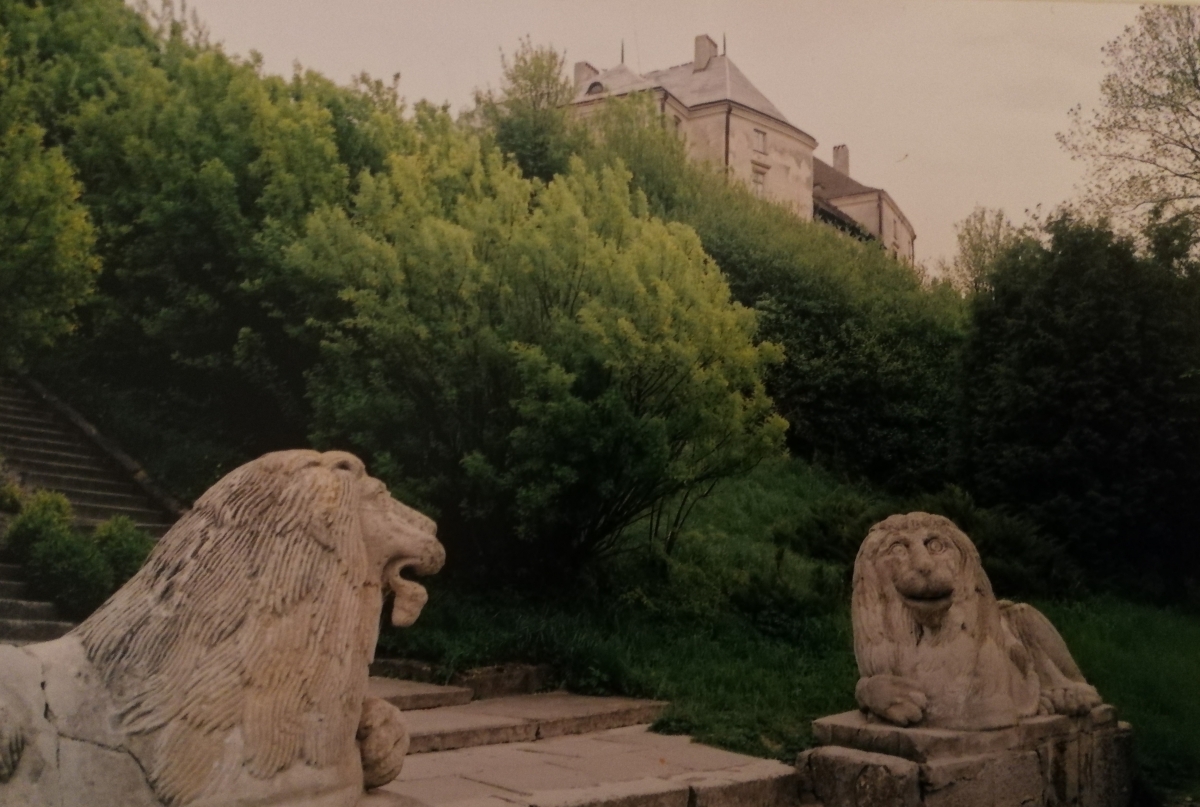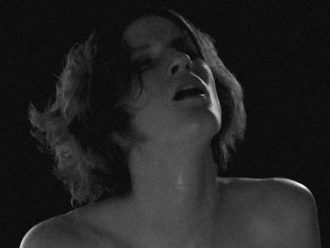The 21st century started for me with a move from Moscow, where I had completed an MA in cultural management at Moscow School of Social and Economic Sciences (MSSES), to Budapest, in order to study on the nationalism MA at the Central European University. Almost immediately, in October 2000, I flew to Kyiv. This mobility in the region felt exciting, as if a new world was opening up before me; but now, at the time of writing, mobility has morphed into instability. Sergei Zuev, the rector of the MSSES, who was the head of my department, is very ill today in a prison hospital, where he is awaiting trial, charged with corruption by Putin’s regime a few months ago. The CEU has been forced out of Nador Street in Budapest to Vienna. Kyiv itself is under siege.
But back then, 22 years ago, I was at Kyiv Contemporary Art Centre to install a work by Artūras Raila and Gintaras Šeputis entitled ‘Nostalgia/Everything Beautiful Is the Past Recycled into Drum’n’bass for Daddy’ as part of Kyiv’s International Multimedia Art Festival (KIMAF). It did not take long to install Raila and Šeputis in Kyiv: we found a television monitor (not a flat screen), and decided to place it at the end of a long corridor, in a corner by a glass door (into which the festival’s director crashed, in a rush just before the opening). I spent the next few days with curators: Katya Stukalova of KIMAF, and Mirko Schaeffer and Richard Pyrker of [d]vision Festival of Digital Culture in Vienna. Katya would later fight at Kyiv’s maidan. Mirko would move to Utrecht University, where he established the Utrecht Data School. I remember Kyiv as an open, very bright and expensive city. Although it was already chilly, we sat shivering in an outdoor cafe in a large tent; this cafe must have been cheaper than the pricey restaurants. The other shards of memory are of touristy sites: the ancient Lavra monastery and its great bell tower, designed by Johann Gottfried Schädel, which we were allowed to climb as the sun was setting over the city; the mind-bogglingly huge complex of the Ministry of Defence; and a massive open-air market, offering a countless choice of objects, gadgets and memorabilia from the Soviet period.
The second time I found myself in Ukraine was a couple of years later, in 2003, no longer as a curator but as a researcher, as part of a study trip organised by the Baltic and East European Graduate School of Södertörno University in Sweden. We flew from Stockholm to Warsaw, and then took a bus to L’viv, stopping in Przemyśl and Lublin (as well as Treblinka), visiting institutes of history and social sciences. It was history fieldwork: all the scholars we met, the texts we read and presentations we listened to merged into a landscape of extravagant Baroque architecture and inconspicuous nature. Whereas in Kyiv I could communicate in Russian, in L’viv I had to resort to my very imperfect Polish. Our group was accommodated in the old town in L’viv, in the Hotel George, built in 1899 and 1900, with an impressive lobby and very high ceilings. The hotel bar had the atmosphere of John le Carré’s novels: in its gloomy light, we drank warm sparkling wine, corks escaping violently from the waiters’ hands. We visited Olesko Castle, whose compact Renaissance architecture grew organically out of the hill. The hillsides themselves were covered with subtle gardens landscaped in the English style, with the scent of blossoming lilac trees and lush grass. It was amazingly quiet. I could not help lying down on the grass, just listening to the wind rustling through it, with the sun beaming down warmth. In one of the castle’s halls, I found a marble bust of Barbora Radvilaitė, the 16th-century Grand Duchess of Lithuania.

Hotel George, Lviv, 2003. Photo: Egle Rindzeviciute
Like Stefan Zweig writing about the sophisticated idyll of Central Europe in the 1930s, I clutch at these memories like straws, at the same time that the Russian army is continuing to attack Ukraine, pulverising its cities and killing its people. Although I have spent very little time in Ukraine, I have spent a lot of time with Ukraine. During my research and doctoral studies in the area studies centre in Stockholm (2001 to 2008), Ukraine was at the centre of academic discussion. Historians, political scientists and sociologists debated endlessly whether the eastern and western parts of Ukraine would part ways, whether the language-based identity of Ukraine’s residents would determine their political identity. However, since Maidan and the occupation of Crimea in 2014, theories based on linguistic determinism do not appear convincing. Looking back, when after four days of hard fighting, Russian-speaking Kharkiv has withstood the Russian army’s attack, those years of debate about east and west Ukraine strike me as time wasted over a non-essential question. To put it more harshly, the discussions themselves could be interpreted as a form of orientalising, a colonial approach that casts East European societies as being blinded by ethnic nationalism and soaked in cultural fundamentalism. As a member of the young generation of scholars, I should have understood the limitations of this view back then. However, the ‘veil’, described by W.E.B. Du Bois was also covering my eyes, and my own consciousness was ‘double’, where the history of parts of Eastern Europe was written and evaluated on the basis of Western stereotypes.
Perhaps that is why, yearning to escape this hierarchical, one-sided narrative of colonial modernity, I turned to science and technology studies (STS), seeking to discern the key features of modern epistemology: the emergence of notions of complex order. I moved away from art and culture to the genealogical investigation of cybernetics and systems theory. But culture did not go away, it kept surfacing, breaking through schematic historiographic narratives in forms that were most fascinating and unexpected. Moreover, when I was exploring the Cold War period, a time when the institutional and epistemological foundations of contemporary governance were being laid, I began, most surprisingly, to uncover forms of classic liberalism of the 19th century. Browsing through Soviet documents in the archives, interviewing Cold War veterans, I could detect these forms of liberalism in ephemeral practices, where the creators of Soviet culture and science chipped away at the frames of ideological politicisation, seeking to open up contact with liberal democracies. For most of them, the late state socialist system was both evil and a vestige of the past. Philosophers, artists, mathematicians, biologists, neuroscientists, engineers and pedagogues, many of them were creating new paths in their own disciplines, moving towards a global, anthropocenic way of seeing, where the principles of dialectical materialism, capitalism and communism, or the nation and the individual, were no longer conceptually expedient. And yet, as three decades have passed since the collapse of the Soviet Union, these principles continue to be invoked by those seeking to concentrate political power. I remain intrigued, however, by those outbreaks of freedom from unfreedom, freedom manifesting in irregularities that are quiet and not declarative, just like the sensorial blast of meaning described by Algirdas Julius Greimas.
I am grasping at my own autobiographical experience because I am not certain what kind of academic writing is ethical in the context of death. I do not want to be trapped in the universalising discourse of ethics. Thinking about what kinds of words I can find in my own subject position, here and now, at a time when in Ukraine houses are being destroyed and lives are being lost, I remembered a talk by the late Leonidas Donskis, delivered in a seminar that I organised at the Paris Institute of Political Studies on 10 June 2015. In this seminar, the title of which was ‘The Ambiguous Role of Culture in the New Cold War’, a panel discussed the tense relations with Russia following Russia’s occupation of Crimea. We also spoke about the possibility of ethical cultural diplomacy. Donskis argued that in principle it is not possible to sort culture into the categories of ‘own’ and ‘alien’, collaborators and opposition, because the very semiotic architecture of culture is characterised by pluralism and heterogeneity, where resistance to a regime can sprout in the most surprising places, and at the most surprising times. Reflecting on Donskis’ words gives me hope that nobody will exhaust our lives and choices with their political strategies, neither from the outside nor from the inside, that some space will be left for the good, generous human spirit, allowing for something unexpected, something else. That the war will not destroy our own humanness. But first, it is necessary to secure peace in Ukraine.

Hotel George, Room, Lviv, 2003. Photo: Egle Rindzeviciute
























